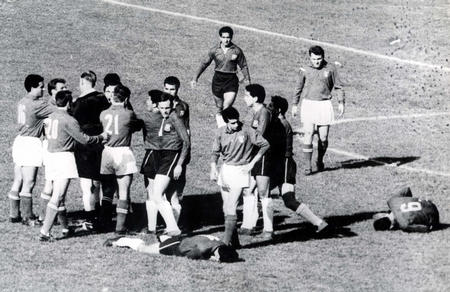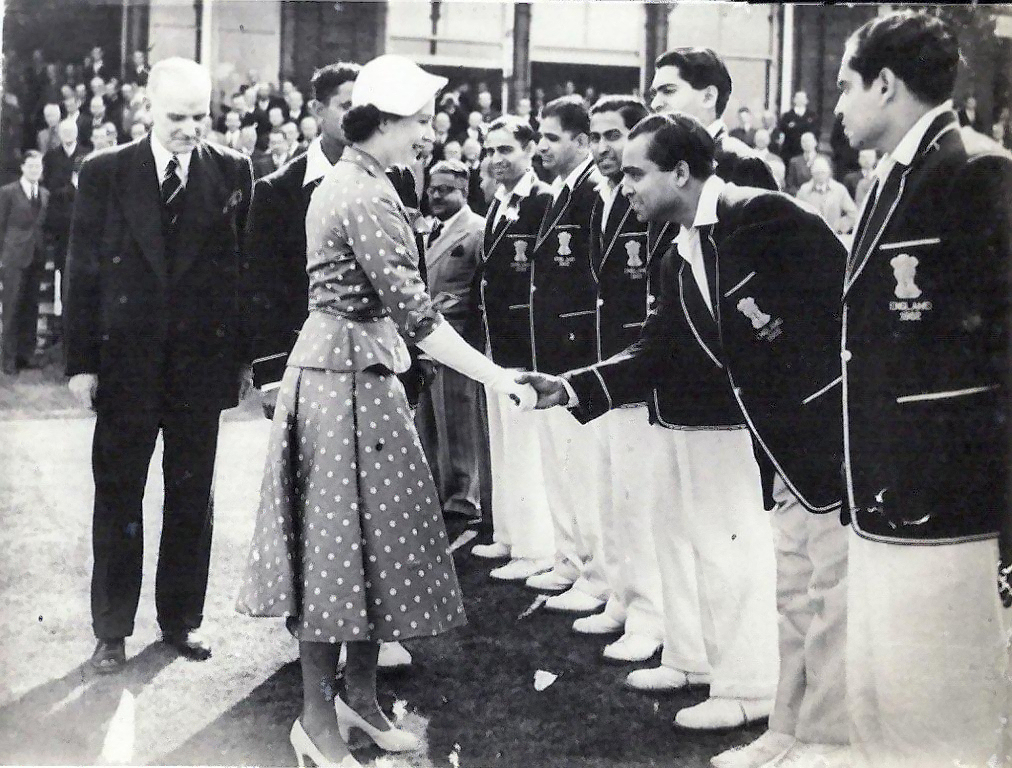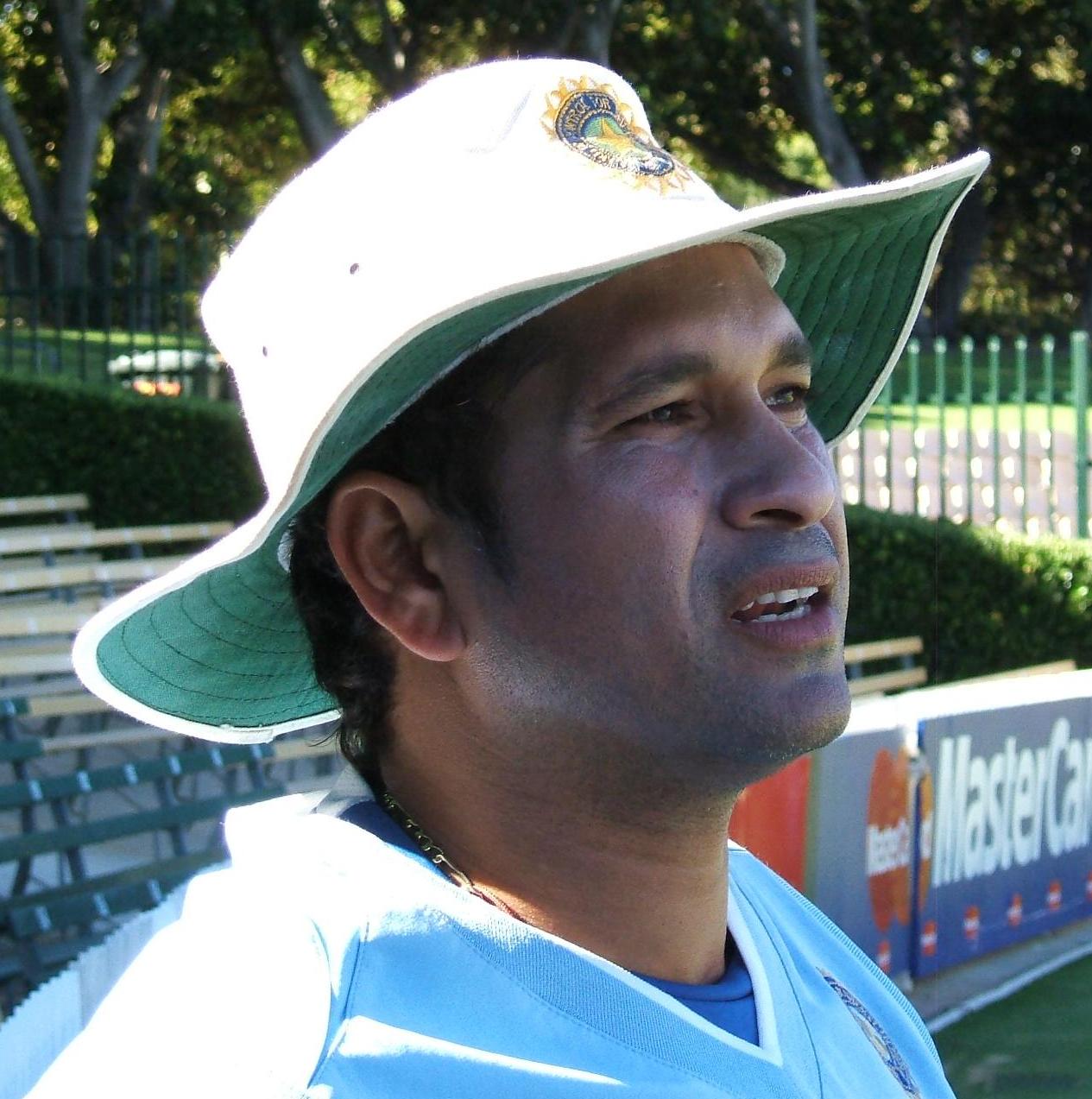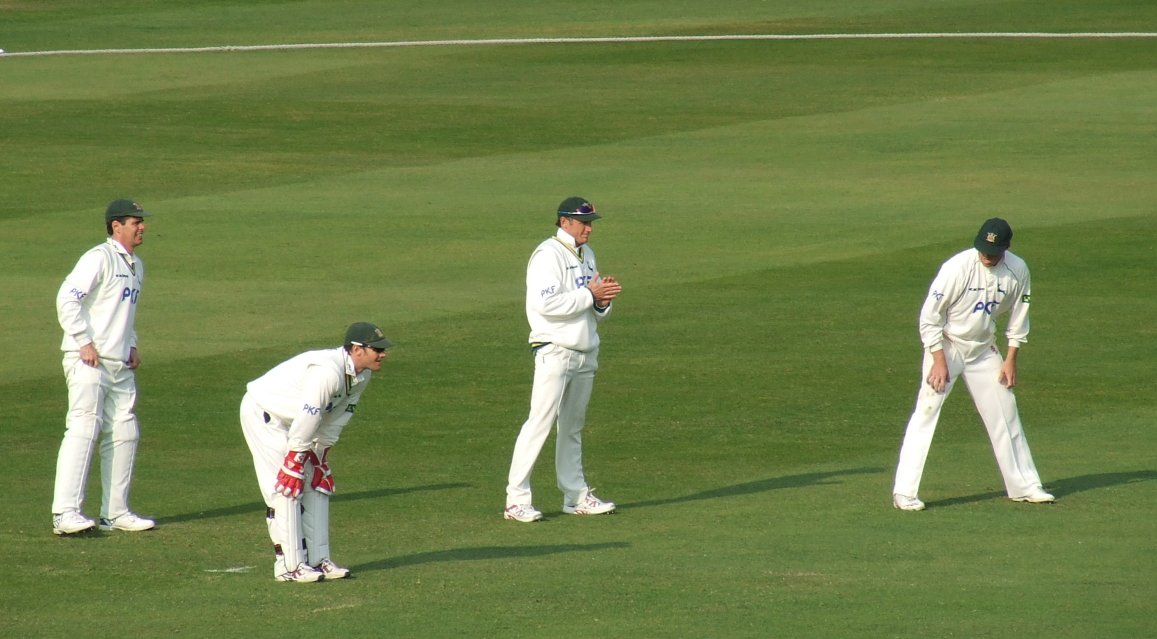|
WG Grace
William Gilbert Grace (18 July 1848 – 23 October 1915) was an English cricketer who is widely considered one of the sport's all-time greatest players. Always known by his initials as "WG", his first-class career spanned a record-equalling 44 seasons from 1865 to 1908. Test cricket originated during his career, and he represented England in 22 matches from 1880 to 1899. In domestic cricket, he was mostly associated with Gloucestershire, the Gentlemen, Marylebone Cricket Club (MCC), and the United South of England Eleven (USEE). Right-handed as both batsman and bowler, Grace was an outstanding all-rounder who excelled at all the essential skills of batting, bowling, and fielding, though it is for his batting that he is most renowned, as he is held to have invented modern batsmanship. He dominated the sport during his career, and his technical innovations and enormous influence have left a lasting legacy. Usually opening the innings, he was particularly admired for his mast ... [...More Info...] [...Related Items...] OR: [Wikipedia] [Google] [Baidu] |
George Beldam
George William Beldam (1 May 1868 – 23 November 1937) was an English first-class cricketer and a pioneer of action photography in sport. George Beldam was the eldest child of a family that was descended from seventeenth-century Huguenot refugees. He studied engineering at Peterhouse, Cambridge, before joining the family engineering company. He captained Peterhouse at cricket, football and tennis, and later played for Brentford F.C. He was a steady right-handed batsman and a right-arm bowler who represented Middlesex, Marylebone Cricket Club (MCC) and London County in first-class cricket between 1900 and 1907. He scored 6,575 runs (average 30.02) with a personal best of 155 * against Surrey at Lord's in 1902 and took 83 catches and 107 wickets (average 30.63) with a personal best of 5/28 versus Lancashire at Liverpool in 1902. He became a noted artist and photographer. He was the first action photographer of sport in Britain, specialising in cricket and golf. He collaborated ... [...More Info...] [...Related Items...] OR: [Wikipedia] [Google] [Baidu] |
First-class Cricket
First-class cricket, along with List A cricket and Twenty20 cricket, is one of the highest-standard forms of cricket. A first-class match is of three or more days scheduled duration between two sides of eleven players each and is officially adjudged to be worthy of the status by virtue of the standard of the competing teams. Matches must allow for the teams to play two innings each, although in practice a team might play only one innings or none at all. The etymology of "first-class cricket" is unknown, but the term was used loosely before it acquired official status in 1895, following a meeting of leading English clubs. At a meeting of the International Cricket Council, Imperial Cricket Conference (ICC) in 1947, it was formally defined on a global basis. A significant omission of the ICC ruling was any attempt to define first-class cricket retrospectively. That has left historians and statisticians with the problem of how to categorise earlier matches, especially those played in ... [...More Info...] [...Related Items...] OR: [Wikipedia] [Google] [Baidu] |
Hurdling
Hurdling is the act of jumping over an obstacle at a high speed or in a sprint. In the early 19th century, hurdlers ran at and jumped over each hurdle (sometimes known as 'burgles'), landing on both feet and checking their forward motion. Today, the dominant step patterns are the 3-step for high hurdles, 7-step for low hurdles, and 15-step for intermediate hurdles. Hurdling is a highly specialized form of obstacle racing, and is part of the sport of athletics (sport), athletics. In hurdling events, barriers known as hurdles are set at precisely measured heights and distances. Each athlete must pass over the hurdles; passing under or intentionally knocking over hurdles will result in disqualification. Accidental knocking over of hurdles is not cause for disqualification, but the hurdles are weighted to make doing so disadvantageous. In 1902 Spalding equipment company sold the Foster Patent Safety Hurdle, a wood hurdle. In 1923 some of the wood hurdles weighed each. Hurdle des ... [...More Info...] [...Related Items...] OR: [Wikipedia] [Google] [Baidu] |
Gamesmanship
Gamesmanship is the use of dubious (although not technically illegal) methods to win or gain a serious advantage in a game or sport. It has been described as "Pushing the rules to the limit without getting caught, using whatever dubious methods possible to achieve the desired end". It may be inferred that the term derives from the idea of playing for the game (i.e. to win at any cost) as opposed to sportsmanship, which derives from the idea of playing for sport. The term was popularized by Stephen Potter's humorous 1947 book, ''The Theory and Practice of Gamesmanship (or the Art of Winning Games without Actually Cheating)''. It had, however, been used before by Ian Coster in his autobiographic book ''Friends in Aspic'', published in 1939, where it was attributed to Francis Meynell. Alleged origins Potter cites the origin of gamesmanship to be a tennis match [...More Info...] [...Related Items...] OR: [Wikipedia] [Google] [Baidu] |
Professional Sports
In professional sports, as opposed to amateur sports, participants receive payment for their performance. Professionalism in sport has come to the fore through a combination of developments. Mass media and increased leisure have brought larger audiences, so that sports organizations or teams can command large incomes. As a result, more sportspeople can afford to make sport their primary career, devoting the training time necessary to increase skills, physical condition, and experience to modern levels of achievement. This proficiency has also helped boost the popularity of sports.Andy Miah Sport & the Extreme Spectacle: Technological Dependence and Human Limits' (PDF) Unpublished manuscript, 1998 In most sports played professionally there are many more amateur than professional players, though amateurs and professionals do not usually compete. History American football American football (commonly known as football in the United States) was professionalized in the 1890s as a s ... [...More Info...] [...Related Items...] OR: [Wikipedia] [Google] [Baidu] |
Amateur Status In First-class Cricket
Amateur status had a special meaning in English cricket. The amateur in this context was not merely someone who played cricket in his spare time but a particular type of first-class cricketer who existed officially until 1962, when the distinction between amateurs and professionals was abolished and all first-class players became nominally professional. Distinctions between amateur and professional status On the face of it, the distinctions between amateurs and professionals in first-class cricket were their availability and their means of remuneration. The professional cricketer received a wage from his county club or, if he went on a tour, a contracted fee paid by the tour organiser. In both cases, there was the possibility of bonuses being earned. The amateur ''in theory'' received expenses only, again paid either by his county club or a tour organiser. Professionals were full-time players during the cricket season and would mostly seek alternative employment in the winter mo ... [...More Info...] [...Related Items...] OR: [Wikipedia] [Google] [Baidu] |
Captain (cricket)
The captain of a cricket team, often referred to as the skipper, is the appointed leader, having several additional roles and responsibilities over and above those of the other players. As in other sports, the captain is usually experienced and has good communication skills, and is likely to be one of the most regular members of the team, as the captain is responsible for the team selection. Before the game the captains toss for innings. During the match the captain decides the team's batting order, who will bowl each over, and where each fielder will be positioned. While the captain has the final say, decisions are often collaborative. A captain's knowledge of the complexities of cricket strategy and tactics, and shrewdness in the field, may contribute significantly to the team's success. Due to the smaller coaching/management role played out by support staff, as well as the need for greater on-field decision-making, the captain of a cricket team typically shoulders mo ... [...More Info...] [...Related Items...] OR: [Wikipedia] [Google] [Baidu] |
Batting (cricket)
In cricket, batting is the act or skill of hitting the cricket ball, ball with a cricket bat, bat to score runs (cricket), runs and prevent the dismissal (cricket), loss of one's wicket. Any player who is currently batting is, since September 2021, officially referred to as a batter regardless of whether batting is their particular area of expertise. Historically, ''batsman'' and ''batswoman'' were used, and these terms remain in widespread use. Batters have to adapt to various conditions when playing on different cricket pitches, especially in different countries; therefore, as well as having outstanding physical batting skills, top-level batters will have quick reflexes, excellent decision-making skills, and be good strategists. During an innings two members of the batting side are on the pitch at any time: the one facing the current delivery from the bowler is called the striker, while the other is the non-striker. When a batter is dismissal (cricket), out, they are replac ... [...More Info...] [...Related Items...] OR: [Wikipedia] [Google] [Baidu] |
Opening Batsman
In cricket, the batting order is the sequence in which batters play through their team's innings, there always being two batters taking part at any one time. All eleven players in a team are required to bat if the innings is completed (i.e., if the innings does not close early due to a declaration or other factor). The batting order is colloquially subdivided into: * Openers (batters one and two) * Top order (batters one to three) * Middle order (batters four to seven) * Lower order or Tailenders (batters eight to eleven) The order in which the eleven players will bat is usually established before the start of a cricket match, but may be altered during play. The decision is based on factors such as each player's specialities; the position each batter is most comfortable with; each player's skills and attributes as a batter; possible combinations with other batters; and the match situation whereby, for example, the team may require a more defensive or attacking player at that p ... [...More Info...] [...Related Items...] OR: [Wikipedia] [Google] [Baidu] |
Fielding (cricket)
Fielding in the sport of cricket is the action of fielders in collecting the ball after it is struck by the striking batter, to limit the number of runs that the striker scores and/or to get a batter out by either catching a hit ball before it bounces, or by running out either batter before they can complete their current run. There are a number of recognised fielding positions and they can be categorised into the offside and leg side of the field. Fielding also involves trying to prevent the ball from making a boundary where four "runs" are awarded for reaching the perimeter and six for crossing it without touching the grass. A fielder may field the ball with any part of their body. However, if, while the ball is in play, he/she wilfully fields it otherwise (e.g. by using their hat) the ball becomes dead and five penalty runs are awarded to the batting side, unless the ball previously struck a batter not attempting to hit or avoid the ball. Most of the rules cover ... [...More Info...] [...Related Items...] OR: [Wikipedia] [Google] [Baidu] |
All-rounder
An all-rounder is a cricketer who regularly performs well at both batting and bowling. Although all bowlers must bat and quite a handful of batsmen do bowl occasionally, most players are skilled in only one of the two disciplines and are considered specialists. Some wicket-keepers have the skills of a specialist batter and have been referred to as all-rounders, but the term '' wicket-keeper-batter'' is more commonly applied to them, even if they are substitute wicket keepers who also bowl. Definition There is no precise qualification for a player to be considered an all-rounder and use of the term tends to be subjective. The generally accepted criterion is that a "genuine allrounder" is someone whose batting or bowling skills, considered alone, would be good enough to win them a place in the team. Another definition of a "genuine all-rounder" is a player who can, through both batting and bowling (though not necessarily both in the same match), consistently "win matches for the ... [...More Info...] [...Related Items...] OR: [Wikipedia] [Google] [Baidu] |
Bowling (cricket)
Bowling, in cricket, is the action of throwing, propelling the cricket ball, ball toward the wicket defended by a batter. A player skilled at bowling is called a ''bowler''; a bowler who is also a competent :Batting (cricket), batter is known as an all-rounder. Bowling the ball is distinguished from throwing (cricket), ''throwing'' the ball by a strictly specified biomechanical definition, which restricts the angle of extension of the elbow. A single act of bowling the ball towards the batter is called a ''ball'' or a ''delivery (cricket), delivery''. Bowlers bowl deliveries in sets of six, called an ''over (cricket), over''. Once a bowler has bowled an over, a teammate will bowl an over from the other end of the pitch. The Laws of Cricket govern how a ball must be bowled. If a ball is bowled illegally, an umpire (cricket), umpire will rule it a ''no-ball''. If a ball is bowled too wide of the striker for the batter to be able to play at it with a proper cricket shot, the bowler' ... [...More Info...] [...Related Items...] OR: [Wikipedia] [Google] [Baidu] |








